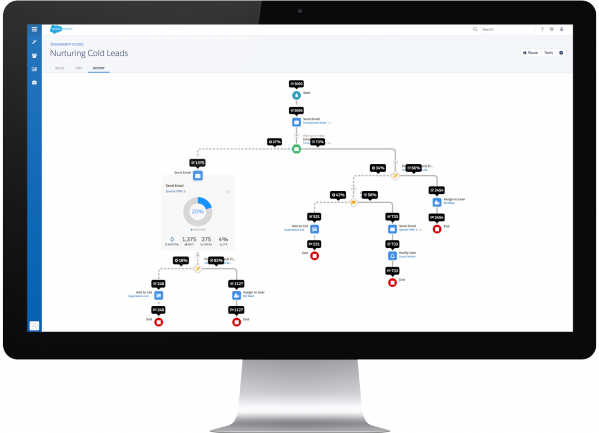


5 Lead nurturing campaigns to convert your prospects into contracts
01 September, 2016
Lead Nurturing 101
Lead nurturing empowers marketers to craft tailored content journeys that take prospects down different routes based on their actions (like clicking through on email links) or data profile in Salesforce (like their lead score or industry vertical).
These campaigns deliver content that supports the sales process and influence prospects throughout the customer journey. Below are five lead nurturing campaigns that help move prospects from "new lead" through to "contract signed."
Note: we've used the Pardot Engagement Studio platform (pictured below) as the basis for these campaigns, but other marketing automation tools also offer lead nurturing functionality.

1. Re-engagement
When starting out with marketing automation, there are often a huge number of historical leads that haven't been touched for some time. Sifting through these old opportunities to find diamonds in the rough is a great first step.
Begin by using your existing CRM data to segment these leads by the product or service they were interested in. Then, put each list of leads on a nurturing campaign for each product or service.
We'd recommend beginning with educational content first, as using a sales-driven approach out of the gate risks spiking unsubscribes (they may not be immediately familiar with your brand if it's been some time since they last heard from you). If prospects engage by clicking through on initial educational emails, then put a "fork" in the journey and send these prospects down a more intensive, sales-driven communication schedule.
At this point, you can start to include automated one-to-one emails from the rep the prospect was originally dealing with to see if you're able to reopen a sales dialogue. Having prospects coming back to you after months or years without any proactive chasing by the sales rep is a great outcome.
2. Researching
Customers at the early stages of their journey are still trying to orientate themselves. They're not yet ready to start speaking with potential providers, but want to understand their options, the market, what they need to consider and what questions they need to ask so they feel comfortable enough to start engaging with prospective companies.
Develop a key piece of educational (not sales) content that helps inform and inspire these customers. The content may be a video, infographic, or white paper. Then, develop a landing page and pay per click advertising campaign that promotes this valuable content and entices people to give up a name, email and (potentially) phone number to get access. This is called "gated content."
Remember, prospects are being asked to give up their personal information so the perceived benefit of receiving this content needs to be greater than the perceived risk of being "sold to."
Once a prospect fills out the form, this should place them on drip nurturing campaign that sends a schedule of related educational (again, not sales) communication over the next 6 - 12 months. The goal is to position your company as a credible expert in your field, ensuring you'll be on their "short list" of people to speak to when they're ready to engage with potential partners.
When prospects complete any online form, their device will be linked with their prospect record and all engagement actions like website page views, email opens and clicks will be tracked and scored in Pardot. You can then set up lead scoring and automation rules that pass these early-stage leads to sales when prospects hit an engagement threshold.
3. Pre & Post Event
Pardot connects seamlessly with event platforms like EventBrite and GoToWebinar. Begin with a generic invitation, and then follow this up with a "fake forward" email from their account manager or key contact at your company, personally inviting them to the event.
If they go on to register, this will score the prospect for their registration and add them to a "pre-event" nurturing schedule with event preparation content (location details, reminders, accommodation, agenda, bios on speakers etc). Following the event, those who attended will go onto a post-event nurturing schedule, distributing related event summary information, seeking feedback on the presentation, and potentially engaging them in a sales dialogue.
4. Post Trade Show
Trade show leads come in one large dump, and it can often be difficult for reps to identify which prospects should be followed up with, and in what order. At the trade show booth, an online form should be set up with an incentive for prospects to provide their information. This should be done in kiosk mode so prospects aren't all associated with that computer as "their device." This should associate prospects with a trade show campaign to track ROI and place them on a post trade show nurturing campaign.
In the form, it's also a good idea to select the person they dealt with so any further nurturing content can come from the rep they spoke to on the day to personalise their experience.
The nurturing campaign should begin with a personal email from their trade show rep, thanking them for attending and inviting them to contact them directly if they can be of any further help. From there, a mix of content related to the themes of the trade show stand should be delivered in relatively quick succession (say a week apart) over the coming 4 - 8 weeks. An automation rule should be set up in Pardot to assign a task in Salesforce for the rep to call the prospect if their campaign is "trade show" and their lead score is over "#." This will ensure that prospects who demonstrate engagement following the show are contacted first.
5. Solution Selection
When you're at the stage where your prospect is evaluating between your solution and a competitor, a solution selection nurturing campaign should be developed for each of your key product or service lines. These are designed to influence stakeholders as they go through this critical stage of their journey. This should position your company as a leader in it's field, with highly relevant case studies, technical data and persuasive company collateral.
We'd recommend using a dynamic list which automatically puts prospects on this drip when their opportunity stage in Salesforce is "reviewing proposal." Then, if the prospect's stage changes to closed won / lost, they're automatically removed from this campaign. Nothing comes across as more authentic than selling to a customer you've already sold to.
Pardot's Engagement Studio has endless applications for nurturing prospects across their lifecycle and these strategies are just the tip of the iceberg. If you're new to implementing Pardot, we'd recommend beginning by focusing 2 - 3 of these campaigns where you see the strongest commercial wins to get you seeing results from the outset.
Lead Nurturing 101
Pardot Engagement Studio empowers marketers to craft tailored content journeys that take prospects down different routes based on their actions (like clicking through on email links) or data profile in Salesforce (like their lead score or industry vertical).
Engagement studio campaigns deliver content that supports the sales process and influence prospects throughout the customer journey. Below are five lead nurturing campaigns that help move prospects from “new lead” through to “contract signed.”
Re-engagement
When starting out with marketing automation, there are often a huge number of historical leads that haven’t been touched for some time. Sifting through these old opportunities to find diamonds in the rough is a great first step.
Begin by using your existing CRM data to segment these leads by the product or service they were interested in. Then, put each list of leads on a nurturing campaign for each product or service.
We’d recommend beginning with educational content first, as using a sales-driven approach out of the gate risks spiking unsubscribes (they may not be immediately familiar with your brand if it’s been some time since they last heard from you). If prospects engage by clicking through on initial educational emails, then put a “fork” in the journey and send these prospects down a more intensive, sales-driven communication schedule.
At this point, you can start to include automated one-to-one emails from the rep the prospect was originally dealing with to see if you’re able to reopen a sales dialogue. Having prospects coming back to you after months or years without any proactive chasing by the sales rep is a great outcome.
Researching
Customers at the early stages of their journey are still trying to orientate themselves. They’re not yet ready to start speaking with potential providers, but want to understand their options, the market, what they need to consider and what questions they need to ask so they feel comfortable enough to start engaging with prospective companies.
Develop a key piece of educational (not sales) content that helps inform and inspire these customers. The content may be a video, infographic, or white paper. Then, develop a landing page and pay per click advertising campaign that promotes this valuable content and entices people to give up a name, email and (potentially) phone number to get access. This is called “gated content.”
Remember, prospects are being asked to give up their personal information so the perceived benefit of receiving this content needs to be greater than the perceived risk of being “sold to.”
Once a prospect fills out the form, this should place them on drip nurturing campaign that sends a schedule of related educational (again, not sales) communication over the next 6 - 12 months. The goal is to position your company as a credible expert in your field, ensuring you’ll be on their “short list” of people to speak to when they’re ready to engage with potential partners.
When prospects complete any online form, their device will be linked with their prospect record and all engagement actions like website page views, email opens and clicks will be tracked and scored in Pardot. You can then set up lead scoring and automation rules that pass these early-stage leads to sales when prospects hit an engagement threshold.
Pre & Post Event
Pardot connects seamlessly with event platforms like EventBrite and GoToWebinar. Begin with a generic invitation, and then follow this up with a “fake forward” email from their account manager or key contact at your company, personally inviting them to the event.
If they go on to register, this will score the prospect for their registration and add them to a “pre-event” nurturing schedule with event preparation content (location details, reminders, accommodation, agenda, bios on speakers etc). Following the event, those who attended will go onto a post-event nurturing schedule, distributing related event summary information, seeking feedback on the presentation, and potentially engaging them in a sales dialogue.
Post Trade Show
Trade show leads come in one large dump, and it can often be difficult for reps to identify which prospects should be followed up with, and in what order. At the trade show booth, an online form should be set up with an incentive for prospects to provide their information. This should be done in kiosk mode so prospects aren’t all associated with that computer as “their device.” This should associate prospects with a trade show campaign to track ROI and place them on a post trade show nurturing campaign.
In the form, it’s also a good idea to select the person they dealt with so any further nurturing content can come from the rep they spoke to on the day to personalise their experience.
The nurturing campaign should begin with a personal email from their trade show rep, thanking them for attending and inviting them to contact them directly if they can be of any further help. From there, a mix of content related to the themes of the trade show stand should be delivered in relatively quick succession (say a week apart) over the coming 4 - 8 weeks. An automation rule should be set up in Pardot to assign a task in Salesforce for the rep to call the prospect if their campaign is “trade show” and their lead score is over “#.” This will ensure that prospects who demonstrate engagement following the show are contacted first.
Solution Selection
When you’re at the stage where your prospect is evaluating between your solution and a competitor, a solution selection nurturing campaign should be developed for each of your key product or service lines. These are designed to influence stakeholders as they go through this critical stage of their journey. This should position your company as a leader in it’s field, with highly relevant case studies, technical data and persuasive company collateral.
We’d recommend using a dynamic list which automatically puts prospects on this drip when their opportunity stage in Salesforce is “reviewing proposal.” Then, if the prospect’s stage changes to closed won / lost, they’re automatically removed from this campaign. Nothing comes across as more authentic than selling to a customer you’ve already sold to.
Pardot’s Engagement Studio has endless applications for nurturing prospects across their lifecycle and these strategies are just the tip of the iceberg. If you’re new to implementing Pardot, we’d recommend beginning by focusing 2 - 3 of these campaigns where you see the strongest commercial wins to get you seeing results from the outset.
Related articles
Using Marketing Automation Across the B2B Customer Journey
05 February, 2016
There's a tendency to think the only use case for marketing automation is at the front of the sales funnel. In reality, marketing automation can become the glue that ties the entire customer journey together. From lead generation and nurturing, through to re-engagement, solution selection, customer onboarding, and proactive account service. Let's take high level look at how marketing automation can enhance the customer experience and drive revenue throughout the customer lifecycle:
MoreHow marketing automation transforms cold calling
10 August, 2015
Cold calling doesn’t work too well with complex sales for a few reasons. First, you have to get lucky - calling a prospect who actually cares about the problem you’re trying to solve at the moment you’ve contacted them. Second, you have to educate them - around who you are, the problem they have and how you’re uniquely positioned to help them solve it. Third, you have limited time - they didn’t ask for the call, and understanding your complex proposition probably isn’t on their list of priorities that day.
MorePlanning your Pardot implementation
14 July, 2016
Beginning the journey towards implementing marketing automation technology is exciting and, as with all things new, contains a few unknowns. Here at LavaBox we've been around the Pardot block a few times and have some useful suggestions to help you plan for your implementation.
MoreLevel 2 - 224 Symonds St
Eden Terrace
Auckland 1024







